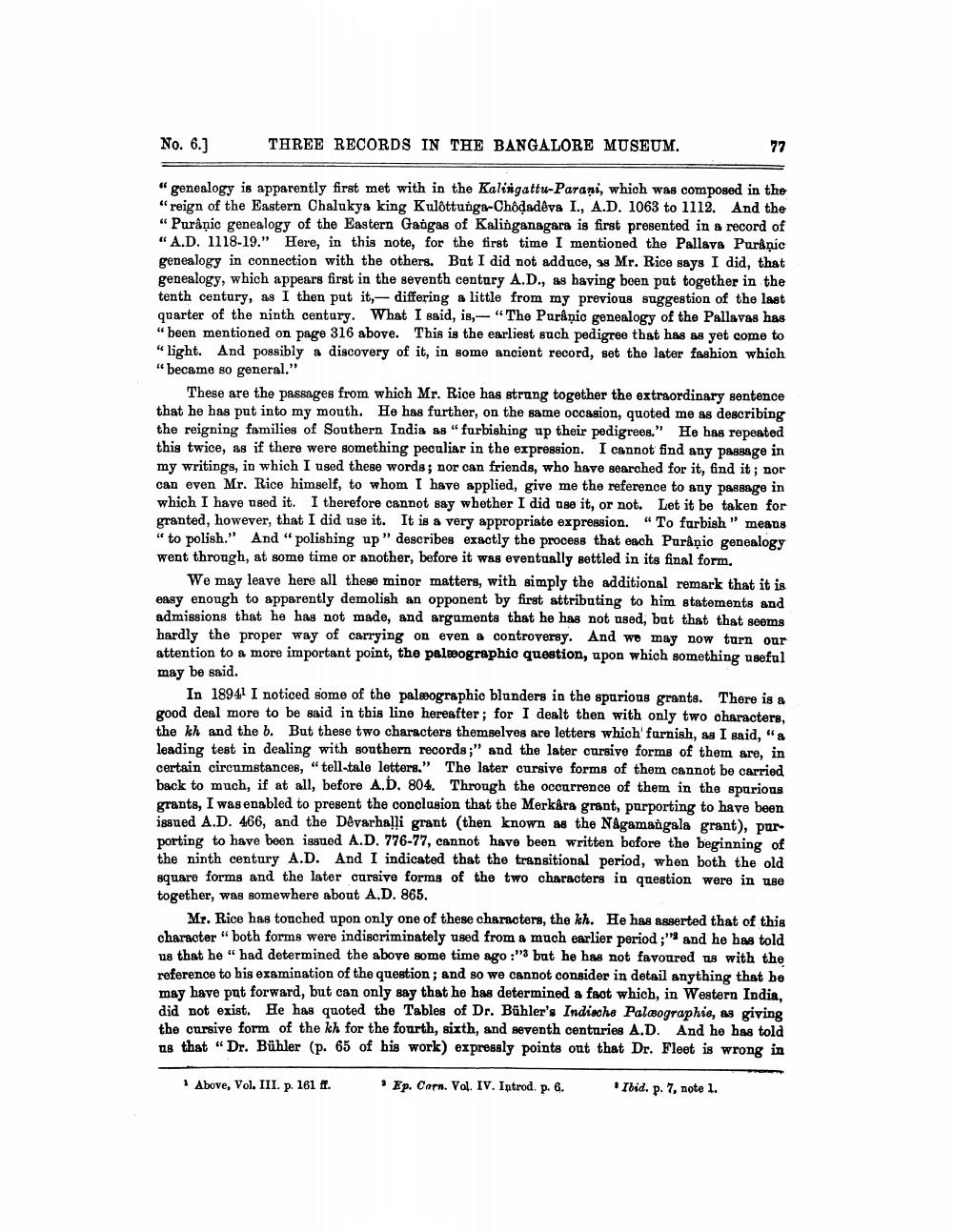________________
No. 6.]
THREE RECORDS IN THE BANGALORE MUSEUM.
« genealogy is apparently first met with in the Kalisigattu-Parani, which was composed in the "reign of the Eastern Chalukya king Kulôttunga-Chôdadêva I., A.D. 1063 to 1112. And the “Puranic genealogy of the Eastern Gaigas of Kalinganagara is first presented in a record of « A.D. 1118-19." Here, in this note, for the first time I mentioned the Pallava Puranic genealogy in connection with the others. But I did not adduce, s Mr. Rice says I did, that genealogy, which appears first in the seventh century A.D., as having been put together in the tenth century, as I then put it,- differing a little from my previous suggestion of the last quarter of the ninth century. What I said, is - "The Purâņic genealogy of the Pallavas has "been mentioned on page 316 above. This is the earliest such pedigree that has as yet come to " light. And possibly a discovery of it, in some ancient record, set the later fashion which " became so general."
These are the passages from which Mr. Rice has strong together the extraordinary sentence that he has put into my mouth. He has further, on the same occasion, quoted me as describing the reigning families of Southern India as "furbishing up their pedigrees." He has repeated this twice, as if there were something peculiar in the expression. I cannot find any passage in my writings, in which I used these words; nor can friends, who have searched for it, find it; nor can even Mr. Rice himself, to whom I have applied, give me the reference to any passage in which I have used it. I therefore cannot say whether I did use it, or not. Let it be taken for granted, however, that I did use it. It is a very appropriate expression. To furbish" means "to polish." And “polishing up" describes exactly the process that each Puråņic genealogy went through, at some time or another, before it was eventually settled in its final form,
We may leave here all these minor matters, with simply the additional remark that it is easy enough to apparently demolish an opponent by first attributing to him statements and admissions that he has not made, and arguments that he has not used, but that that seems hardly the proper way of carrying on even a controversy. And we may now turn our attention to a more important point, the paleographic question, upon which something useful may be said.
In 18941 I noticed some of the palæographic blunders in the spurious grants. There is a good deal more to be said in this line hereafter; for I dealt then with only two characters, the kh and the b. But these two characters themselves are letters which' furnish, as I said, "S leading test in dealing with southern records;" and the later cursive forms of them are, in certain circumstances, "tell-tale letters." The later cursive forms of them cannot be carried back to much, if at all, before A.D. 804. Through the occurrence of them in the spurions grants, I was enabled to present the conclusion that the Merkara grant, purporting to have been issued A.D. 466, and the Devarhalli grant (then known as the Nagamangala grant), par porting to have been issued A.D. 776-77, cannot have been written before the beginning of the ninth century A.D. And I indicated that the transitional period, when both the old square forms and the later cursive forms of the two characters in question were in use together, was somewhere about A.D. 865.
Mr. Rice has touched upon only one of these characters, the kh. He has asserted that of this character "both forms were indiscriminately used from a much earlier period;" and he has told us that he had determined the above some time ago :"3 but he has not favoured us with the reference to his examination of the question; and so we cannot consider in detail anything that he may have put forward, but can only say that he has determined a faot which, in Western India, did not exist. He has quoted the Tables of Dr. Bühler's Indische Palcographie, as giving the cursive form of the kh for the fourth, sixth, and seventh centuries A.D. And he has told as that "Dr. Bühler (p. 65 of his work) expressly points out that Dr. Fleet is wrong in
Above, Vol. III. p. 161 ff.
Ep. Corn. Vol. IV. Introd, p. 6.
* Ibid. p. 7, note 1.




